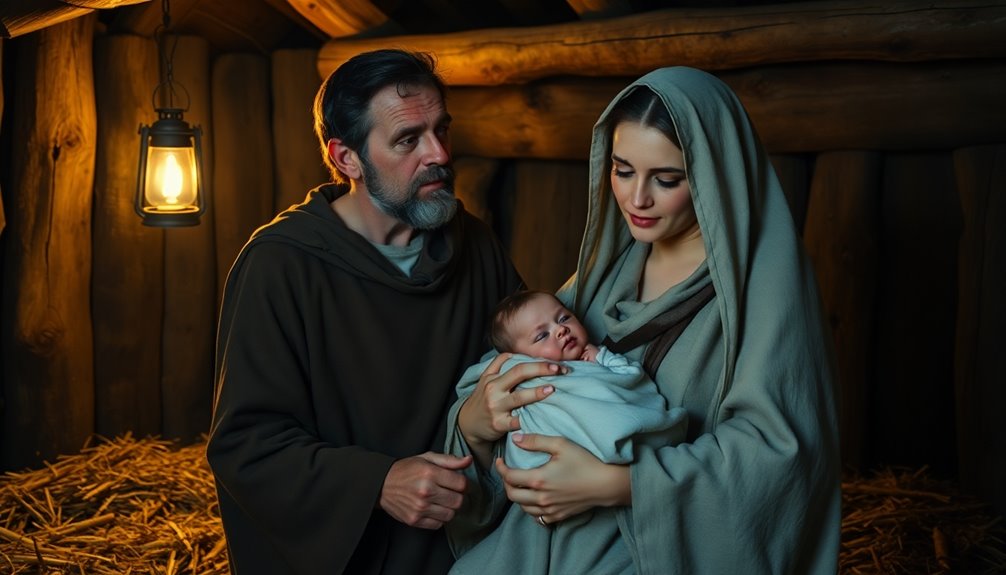Mary and Joseph weren't outright poor, but they faced financial struggles. Their offering of two turtledoves at the temple hints at their limited means, as it was an alternative for those who couldn't afford a lamb. Joseph's skilled trade provided a modest income, ensuring some stability in their lives. Their royal lineage adds another layer to their economic status, showing a mix of challenge and heritage. There's much more to explore about their unique circumstances.
Mary and Joseph's story often conjures images of poverty and struggle, but the reality may be more nuanced. While it's true that they offered two turtledoves or pigeons at the temple, this act is often interpreted as a sign of financial struggles. According to Leviticus 12:8, this offering was the prescribed alternative for those who couldn't afford a lamb, which paints a picture of their economic status. However, it's essential to recognize that this offering doesn't alone define their entire financial situation.
Joseph's occupation as a "tektōn," which translates to builder or craftsman, suggests he'd a skilled trade. This implies he likely earned a modest income, enough to support his family without being destitute. You might consider that Joseph's trade reflects a level of stability, especially in a small village like Nazareth, where economic opportunities were limited. Their modest income would have placed them in a category that's neither rich nor impoverished, adding complexity to the narrative of poverty surrounding Mary and Joseph.
Moreover, their lineage from King David raises intriguing questions about their socioeconomic status. Being of royal descent could imply some level of financial stability, regardless of the humble circumstances of Jesus' birth. You can see that while they lived modestly, their family background may have provided them with certain advantages that aren't immediately apparent in the tales of their struggles.
Archaeological evidence reveals that Nazareth was an agricultural village with limited economic prospects. This context contributes to the perception of Mary and Joseph as poor, but it's important to remember that financial hardship was common in their society. While they may have faced challenges, there's no explicit biblical evidence confirming that they were entirely destitute.
Instead, their story reflects broader economic circumstances of their time. They navigated the challenges of their environment while also carrying a lineage that hinted at greater possibilities. In your understanding of Jesus' origins, consider that Mary and Joseph's lives were likely a blend of struggle and modest stability rather than outright poverty. Their experiences remind us that financial struggles can exist alongside a rich lineage and skilled labor, framing the story of Jesus in a more multifaceted light.
Frequently Asked Questions
Were Mary and Joseph Rich or Poor?
When you think about whether Mary and Joseph were rich or poor, consider their situation.
They offered two turtledoves, which might suggest financial struggle, but this was a provision for those with limited means.
Joseph, being a skilled craftsman, likely provided a stable income.
Plus, the gifts from the Magi could've helped them during tough times.
Was Joseph the Carpenter Wealthy?
Imagine a humble workshop, where the smell of sawdust mingles with dreams of sturdy homes.
You might wonder if Joseph, the builder, was wealthy. While he likely wasn't rich, his skilled trade provided a stable income, allowing him to support his family in a modest way.
The sacrifices he made at the temple hint at some financial strain, but they don't paint a complete picture of his economic standing.
Wealth, after all, is relative.
Was St. Joseph Poor?
When you consider whether St. Joseph was poor, it's essential to look at his background and trade.
As a carpenter, he likely had a modest income, providing for his family. While his offering at the temple might suggest financial struggle, it doesn't definitively prove he was destitute; many chose that option for various reasons.
What Shows That Jesus Came From a Poor Family?
You can see evidence of Jesus coming from a poor family through their offerings at the temple.
Mary and Joseph presented two turtledoves, a sacrifice allowed for those who couldn't afford a lamb.
Additionally, they lived in Nazareth, a small village with limited resources.
The humble conditions of Jesus' birth in a stable further highlight their modest means.
These factors collectively suggest that Jesus' family faced financial constraints throughout His early life.
Conclusion
In the grand tapestry of history, Mary and Joseph's poverty shines like a thousand suns! They didn't just scrape by; they were on the financial brink of oblivion, living in a world where a single coin felt like a fortune. Their humble beginnings didn't just shape their lives; they set the stage for a revolutionary figure! So, when you think of their struggle, remember: it wasn't just about lack; it was about the extraordinary hope born from utter destitution!










